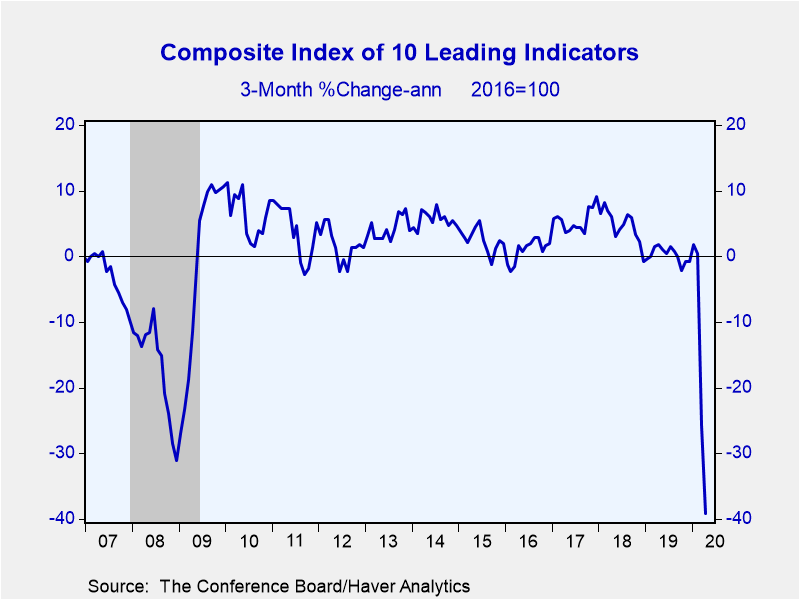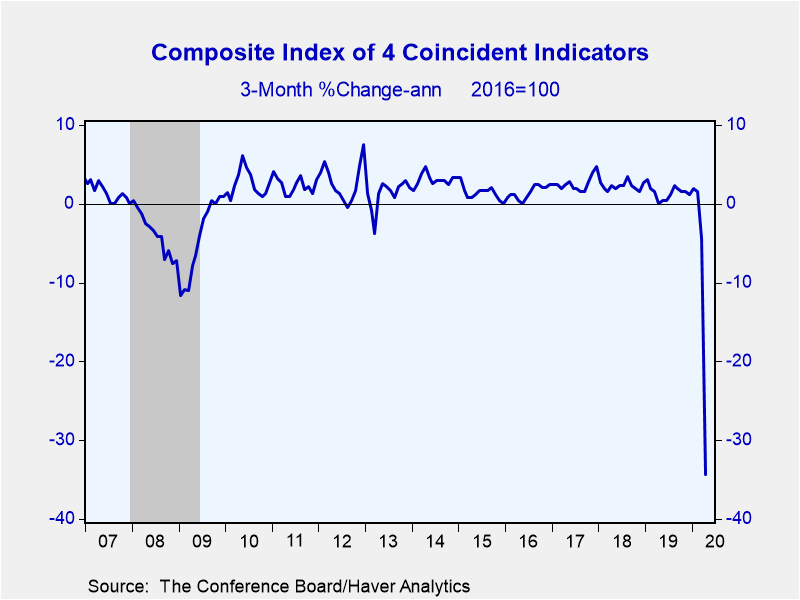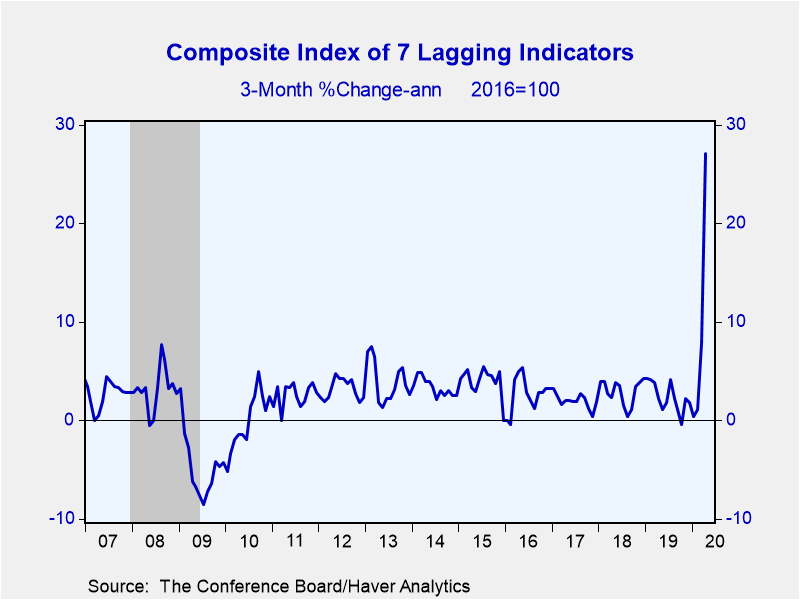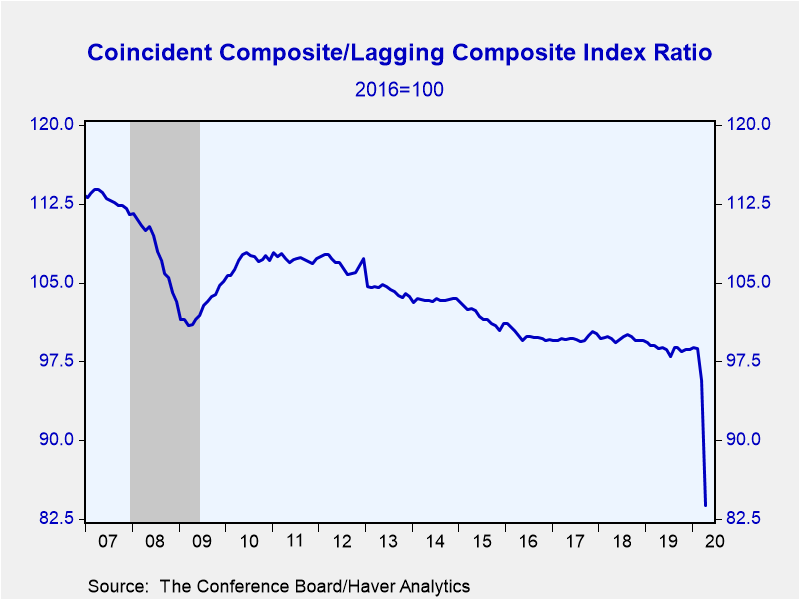 Global| May 21 2020
Global| May 21 2020U.S. Leading Economic Indicators Fall Sharply Again in April
by:Tom Moeller
|in:Economy in Brief
Summary
• Reflecting impact of pandemic, total leading index declines 4.4% in April, following record 7.4% drop in March. • Coincident indicators confirm deep economic recession. • Lagging indicators detect labor market stress. The Conference [...]
• Reflecting impact of pandemic, total leading index declines 4.4% in April, following record 7.4% drop in March.
• Coincident indicators confirm deep economic recession.
• Lagging indicators detect labor market stress.
The Conference Board reported that its Composite Index of Leading Economic Indicators declined 4.4% (-11.5% y/y) in April following a record 7.4% weakening in March, revised from -6.7%. A 5.7% decline had been expected in the Action Economics Forecast Survey. The series is comprised of 10 components which tend to precede changes in the overall economy.
Last month's weakness in the leading index again reflected widespread declines amongst the component series. The largest negative contributions came from higher initial unemployment insurance claims which accounted for 1.4 percentage points of the total's decline. A shorter workweek accounted for 1.8 percentage points of the decline and a lower ISM new orders reading sapped 0.6 percentage points. Fewer building permits also contributed negatively, as did the leading credit index and consumer expectations for business/economic conditions. Contributing positively to the leading index change were stock prices and the interest rate spread between 10-year Treasuries and Fed funds. New orders for consumer & capital goods exhibited little effect on the leading index change.
Three-month growth in the leading index weakened to a record -39.2% (AR).
The Index of Coincident Economic Indicators declined 8.9% (-9.0% y/y), by far a record, following a 1.5% March drop, revised from -0.9%. Reduced payroll employment subtracted 7.7 percentage points from the index change and industrial production also fell sharply. Personal income less transfer payments and manufacturing & trade sales made slight positive contributions to the index change.
Three-month growth in the coincident index plunged a record -34.3% (AR).
The Index of Lagging Economic Indicators strengthened 4.1% last month (7.3% y/y) after rising 1.7% in March, revised from 1.2%. Contributing positively to the index change was the average duration of unemployment. It accounted for virtually all of the index rise. Commercial & industrial loans outstanding accounted for a little less than one percentage to the index gain, about as it did in March. Growth in the services CPI exhibited a sharply negative effect as did the prime rate charged by banks. Other series had little influence on the lagging index change.
Three-month growth in the lagging index surged to a record 27.1% (AR).
The ratio of coincident-to-lagging economic indicators is considered another leading indicator of economic activity. It plunged to a record low.
The Conference Board figures are available in Haver's BCI database; the components are available there, and most are also in USECON. The expectations are in the AS1REPNA database. Visit the Conference Board's site for coverage of leading indicator series from around the world.
Interim Economic Projections for 2020 and 2021 from the Congressional Budget Office is available here.
| Business Cycle Indicators (%) | Apr | Mar | Feb | Apr Y/Y | 2019 | 2018 | 2017 |
|---|---|---|---|---|---|---|---|
| Leading | -4.4 | -7.4 | -0.2 | -11.5 | 1.6 | 5.7 | 3.9 |
| Coincident | -8.9 | -1.5 | 0.3 | -9.0 | 1.8 | 2.5 | 2.2 |
| Lagging | 4.1 | 1.7 | 0.4 | 7.3 | 2.8 | 2.5 | 2.4 |
Tom Moeller
AuthorMore in Author Profile »Prior to joining Haver Analytics in 2000, Mr. Moeller worked as the Economist at Chancellor Capital Management from 1985 to 1999. There, he developed comprehensive economic forecasts and interpreted economic data for equity and fixed income portfolio managers. Also at Chancellor, Mr. Moeller worked as an equity analyst and was responsible for researching and rating companies in the economically sensitive automobile and housing industries for investment in Chancellor’s equity portfolio. Prior to joining Chancellor, Mr. Moeller was an Economist at Citibank from 1979 to 1984. He also analyzed pricing behavior in the metals industry for the Council on Wage and Price Stability in Washington, D.C. In 1999, Mr. Moeller received the award for most accurate forecast from the Forecasters' Club of New York. From 1990 to 1992 he was President of the New York Association for Business Economists. Mr. Moeller earned an M.B.A. in Finance from Fordham University, where he graduated in 1987. He holds a Bachelor of Arts in Economics from George Washington University.










